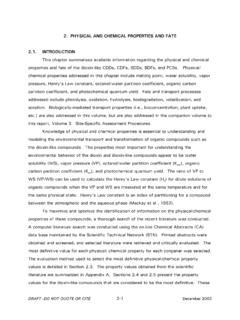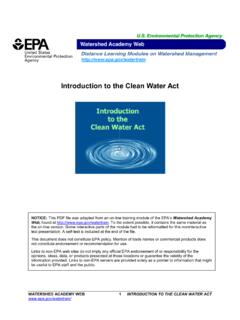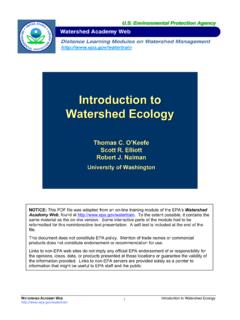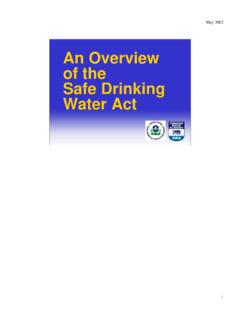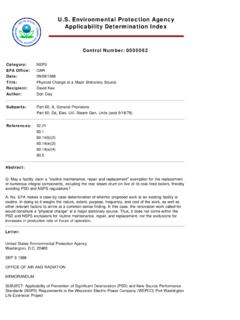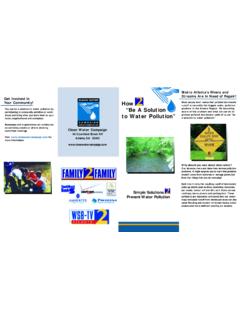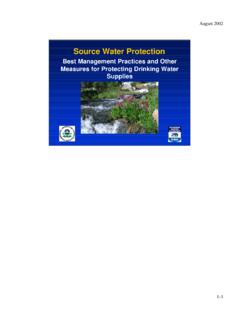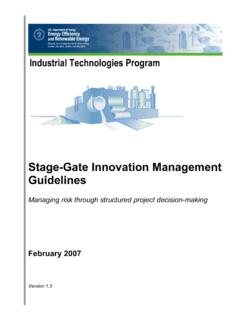Transcription of METHYLENE DIPHENYL DIISOCYANATE (MDI)
1 TOXICOLOGICAL REVIEW of METHYLENE DIPHENYL DIISOCYANATE (MDI) (CAS No. 101-68-8 and 9016-87-9) In Support of Summary Information on the Integrated Risk Information System (IRIS) February 1998 ENVIRONMENTAL PROTECTION AGENCY WASHINGTON, DC TABLE OF CONTENTS TOXICOLOGICAL REVIEW FOR METHYLENE DIPHENYL DIISOCYANATE (MDI) (CASRN No. 101-68-8 and 9016-87-9) Disclaimer ..i Foreword .. ii Contributors and Reviewers .. iii 1. Introduction .. 1 2. Chemical and Physical Information Relevant to Assessments .. 2 3. Toxicokinetics Relevant to Assessments .. 3 4. Hazard Identification .. 4 Studies in humans - epidemiology, case reports, clinical controls .. 4 Pre-chronic, chronic studies and cancer bioassays in animals .. 12 Reproductive/developmental studies .. 19 Other studies .. 20 Synthesis and evaluation of major noncancer effects and mode of action .. 22 Weight of evidence evaluation and cancer characterizations - synthesis of human, animal and other supporting evidence, conclusions about human carcinogenicity, and likely mode of action.
2 23 Susceptible populations .. 24 Possible childhood .. 24 Possible gender differences ..25 5. Dose Response Assessments .. 25 Oral Reference Dose (RfD) .. 25 Inhalation Reference Concentration (RfC) .. 25 Choice of principal study and critical 25 Methods of analysis - including 26 RfC derivation - including application of uncertainty factors (UF) and modifying factors (MF) .. 26 CONTENTS (continued) Cancer assessment .. 27 6. Major Conclusions in Characterization of Hazard and Dose-Response .. 27 Hazard identification .. 27 Dose-response .. 29 7. References .. 31 8. Appendices .. 40 Appendix A: RfC Benchmark Concentration Analyses of Data from Reuzel et al. 1990, 40 Appendix B: Summary of and Response to External Peer Review Comments .. 43 Appendix C: Regional Deposited Dose Ratios .. 47 DISCLAIMER Mention of trade names or commercial products does not constitute endorsement or recommendation for use.
3 I FOREWORD The purpose of this review is to provide scientific support and rationale for the hazard identification and dose-response assessments for both cancer and noncancer effects (the inhalation reference concentration [RfC]), from chronic exposure to monomeric METHYLENE DIPHENYL DIISOCYANATE (MDI) and polymeric MDI (PMDI). It is not intended to be a comprehensive treatise on the chemical or toxicological nature of either MDI or PMDI. In Section 6, EPA has characterized its overall confidence in the quantitative and qualitative aspects of hazard and dose-response ( EPA, 1995a). Matters considered in this characterization include knowledge gaps, uncertainties, quality of data, and scientific controversies. This characterization is presented in an effort to make apparent the limitations of the individual assessments and to aid and guide the risk assessor in the ensuing steps of the risk assessment process.
4 For other general information about this assessment or other questions relating to IRIS, the reader is referred to EPA s Risk Information Hotline at 202-566-1676. ii CONTRIBUTORS AND REVIEWERS Chemical Manager/Author Mark M. Greenberg National Center for Environmental assessment Office of Research and Development Environmental Protection Agency Research Triangle Park, NC 27707 Reviewers This document and summary information on IRIS have received peer review both by EPA scientists and by independent scientists external to EPA ( EPA, 1994a). Subsequent to external review and incorporation of comments, this assessment has undergone an Agencywide review process whereby the IRIS Program Manager has achieved a consensus approval among the Office of Research and Development, Office of Air and Radiation, Office of Prevention, Pesticides, and Toxic Substances, Office of Solid Waste and Emergency Response, Office of Water, Office of Policy Planning and Evaluation and the Regional Offices.
5 Internal EPA Reviewers James W. Holder, Toxicologist National Center for Environmental assessment Environmental Protection Agency Washington, DC Cheryl Scott Epidemiologist National Center for Environmental assessment Environmental Protection Agency Washington, DC Eric D. Clegg, Toxicologist National Center for Environmental assessment Environmental Protection Agency Washington, DC iii External Peer Reviewers Charles H. Hobbs, DVM Director of Toxicology Lovelace Biomedical and Environmental Research Institute Albuquerque, NM Thomas Ledoux, Division of Science and Research New Jersey Department of Environmental Protection Trenton, NJ William E. Brown, Professor and Head Department of Biological Sciences Carnegie Mellon University Pittsburgh, PA Summaries of the external peer reviewers comments and the disposition of their recommendations are in Appendix B. iv 1. Introduction This document presents the derivation of the noncancer concentration-response assessment for inhalation exposure, the inhalation reference concentration (RfC), and the cancer hazard assessment .
6 There are no data with which to evaluate toxicological effects via the oral route; thus, a derivation of the oral reference dose has not been presented. The RfC is meant to provide information on long-term toxic effects other than carcinogenicity. The RfC is based on the assumption that thresholds exist for certain toxic effects such as cellular necrosis, but may not exist for other toxic effects such as some carcinogenic responses. The RfC is expressed in mg/m3. In general, the RfC is an estimate (with uncertainty spanning perhaps an order of magnitude) of a daily exposure to the human population (including sensitive subgroups) that is likely to be without appreciable risk of deleterious noncancer effects during a lifetime. The RfC considers toxic effects for both the respiratory system (portal-of-entry) and for effects peripheral to the respiratory system (extrarespiratory or systemic effects).
7 The carcinogenicity hazard assessment reflects a weight-of-evidence judgment of the likelihood that the agent is a human carcinogen as well as the conditions under which any carcinogenic effects may be manifested. The information available is insufficient to derive a quantitative risk estimate for MDI. Development of these hazard identifications and the concentration-response assessment for MDI has followed the general guidelines for risk assessments as set forth by the National Research Council (1983). Other EPA guidelines that were used in the development of this assessment include the following: the Risk assessment Guidelines ( EPA, 1987), the Guidelines for Carcinogen Risk assessment ( EPA, 1986), the (new) Proposed Guidelines for Carcinogen Risk assessment ( EPA, 1996a), Guidelines for Developmental Toxicity Risk assessment ( EPA, 1991), (proposed) Interim Policy for Particle Size and Limit Concentration Issues in Inhalation Toxicity ( EPA, 1994b), (proposed) Guidelines for Neurotoxicity Risk assessment ( EPA, 1995b), Methods for Derivation of Inhalation Reference Concentrations and Application of Inhalation Dosimetry ( EPA, 1994c), Recommendations for and Documentation of Biological Values for Use in Risk Assessments ( EPA, 1988), and the Use of the Benchmark Dose Approach in Health Risk assessment ( EPA, 1995c).
8 The literature search strategy employed for this compound was based on the CASRN and at least one common name. At a minimum, the following databases were searched: RTECS, HSDB, TSCATS, CCRIS, GENETOX, EMIC, EMICBACK, DART, ETICBACK, TOXLINE, 1 CANCERLINE, MEDLINE, and MEDLINE backfiles. Recently published information was tracked via Current Contents. Any pertinent information submitted by the public to the Integrated Risk Information System (IRIS) submission desk also was considered in the development of this document 2. Chemical and Physical Information Relative to Assessments METHYLENE DIPHENYL DIISOCYANATE (MDI) in commercial form typically exists as a mixture of 4,4'-MDI (monomer) and certain oligomers of MDI (Encyclopedia of Chemical Technology, 1983). It has a CASRN of 9016-87-9. The content of monomeric MDI generally is between 45% and 65% on a w/w basis (Mobay, 1983). The mixture is designated as polymeric MDI (PMDI).
9 It contains about 50% monomeric MDI and 50% trimeric species and higher molecular weight oligomers (Ulrich, 1983); this composition, which is very similar to that used in the workplace, renders the material semisolid and suitable for aerosol generation. Monomeric MDI (CASRN 101-68-8) is formed as a byproduct of PMDI synthesis and is rarely separated from the mixture except in special-use applications. The generic structure of PMDI is shown in Figure 1. Figure 1. Representation of polymeric MDI in generic form. The exact composition of monomeric MDI in the mixture likely varies with the manufacturer. Any change in the monomeric composition is expected to be compensated by an increase or decrease in oligomer content. Only monomeric MDI (herein referred to as MDI) is listed as a hazardous pollutant under section 112g of the Clean Air Act Amendments of 1990. Both MDI and PMDI are reactive with water, with resultant production of amines, oligoureas, and carbon dioxide.
10 For this reason, PMDI is always stored under an inert gas such as nitrogen until use. In practice, PMDI is stored at room temperature. 2 Monomeric MDI is a solid at room temperature; the PMDI mixture is a viscous liquid. The vapor pressure of both the monomer and PMDI is extremely low, about 2 10-6 kPa at 20 C (CMA, 1994). Both MDI and PMDI exist in workplace air primarily as aerosols generated during polyurethane foam formation (Dharmarajan and Weill, 1978; Dharmarajan, 1979). In field studies involving PMDI and conventional airless spraying equipment, these investigators found that, in contrast to impingers without filters, more than 78% of the material collected on Teflon filters with stainless steel backup pads upstream of the impingers was either urethane or MDI urea, since MDI was not detected in the leached material. The size distribution of the particles, determined with a seven-stage cascade impactor, had a mass median aerodynamic diameter (MMAD) of m with a sigma g of When pure MDI was heated under laboratory conditions, a m pore-size Teflon filter blocked more than 87% of the MDI entering the impinger.
